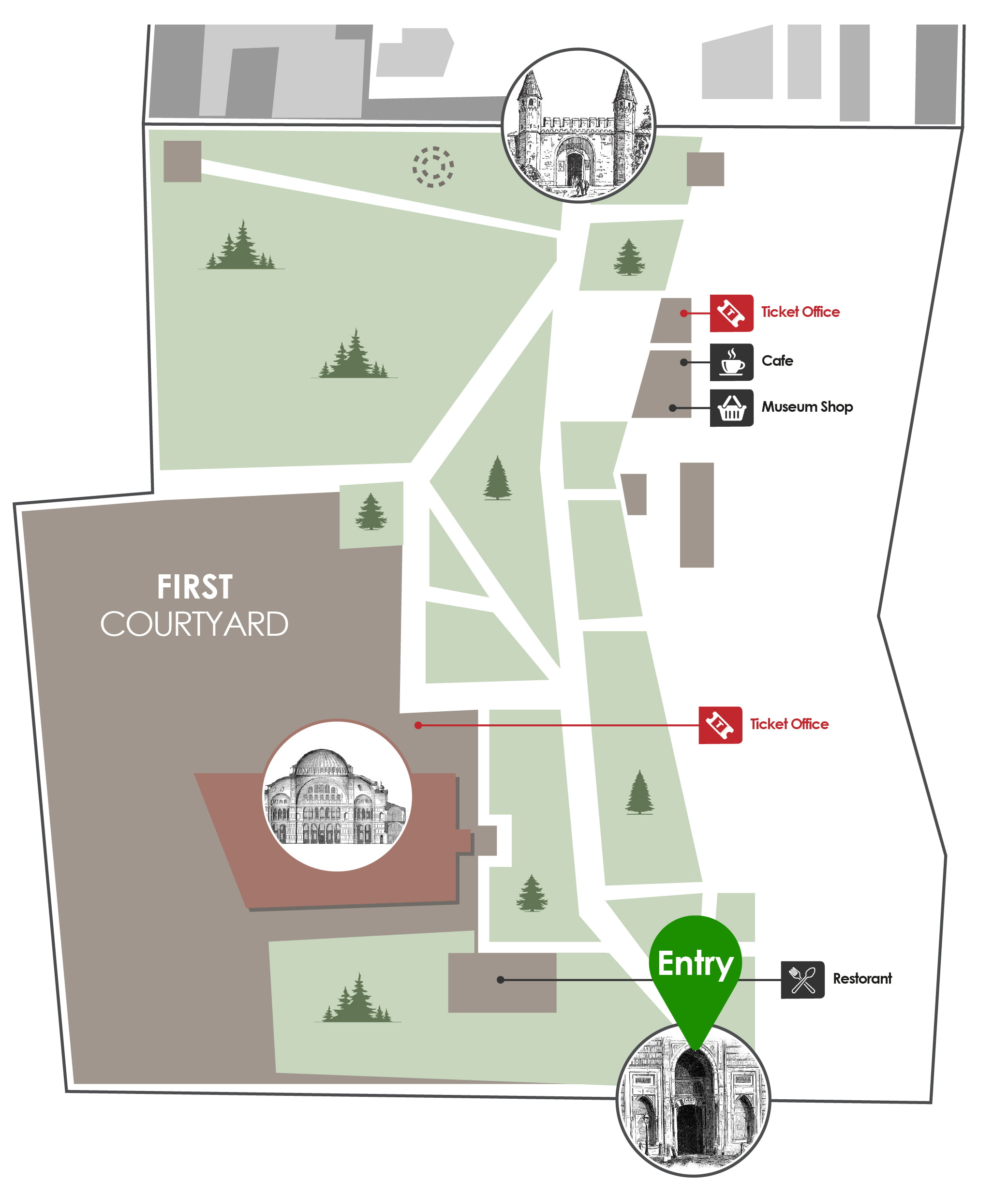Discover Dolmabahçe Palace
Learn about its collection, history, architecture, and more
A Masterpiece of Late Ottoman Architecture & History: Dolmabahçe Palace
HISTORY
The area where Dolmabahçe Palace is located was originally a bay that had served as a natural harbour since antiquity.
It is thought to be from here that Sultan Mehmed II (The Conqueror) had his ships hauled over a wooden ramp so as to launch them into the Golden Horn. The Ottoman naval fleet used to anchor in the bay and naval ceremonies were held here.
The bay was filled in from the 17th century onwards, and so given the name “Dolmabahçe” (filled garden) and was used as an Imperial Garden.
All the buildings in the complex prior to the 19th century were named “Beşiktaş Waterfront Palace”.
Apart from its main building parallel to the Bosphorus, Dolmabahçe Palace consists of diverse buildings used for specific purposes, including a glass factory, foundry, aviary and stables.
The complex also includes the Apartment of the Crown Prince as well as the Clock Tower and Departure Kiosks behind the Apartment of the Crown Prince constructed during Sultan Abdülhamid II’s reign (1876-1909).
During the reign of Sultan Abdülmecid (1839-1861), Beşiktaş Waterfront Palace which had become impractical, was demolished and Dolmabahçe Palace was constructed by the imperial architects Karabet Balyan, Ohannes Serveryan, Nikogos Balyan and James William Smith.
Two building supervisors, Hacı Said Aga (1843-1850) and (1850-1856) Esseyid Ali Şahin Bey were commissioned.
The main structure that consists of two regular floors, one attic and one basement, is divided into three sections with separate functions.
These are the Administrative Section (Mabeyn-i Hümâyûn) where the country’s affairs were discussed, the Private Section (Harem) where the Sultan and his family were living and between these the Grand Ceremonial Hall where the Sultan received notables of the state on religious days and where state ceremonies were held.
The palace has 285 rooms, 44 halls, 68 toilets and 6 Turkish baths. As a monoblock building, it is the biggest palace in Turkey, with a ground area of 14.595 m2.
The palace was inhabited from the year 1856 by six Sultans and the last Caliph: Sultan Abdülmecid (1839-1856), Sultan Abdülaziz (1861-1876), Sultan Murad V (1876), Sultan Abdülhamid II (1876-1909), Sultan Mehmed Reşad V (1909-1918) Sultan Mehmed VI Vahideddin (1918-1922) and the last Caliph Abdülmecid (1922-1924).
After the foundation of the Republic, Mustafa Kemal Atatürk stayed temporarily in the palace for a total of 4 years, between 1927-1938. He worked from the palace and passed away there.
The palace was used as a presidential residence during the term of İsmet İnönü till the year 1949, and was opened to the public as a palace-museum with its original furnishings in 1984.
Functionally and architecturally, the palace preserves the traditional Turkish house layout of a hall in the middle with rooms surrounding it; nevertheless, Western decoration in styles such Baroque, Rococo, Neo-Classic were widely used. Thus, traditional Ottoman stylistic and cultural elements were blended with a Western approach, resulting in a new interpretation.
Hereke carpets, Baccarat crystals, Sèvres and Yıldız porcelains, gifts by various state leaders and paintings by Western artists were used for the decoration of the walls and floors of the palace.






Dolmabahçe PALACE COLLECTIONS
Collection of Dolmabahçe Palace
Explore the rich collections of Dolmabahçe Palace.
From magnificent crystal chandeliers and intricate porcelain to the opulent furnishings and priceless works of art, the palace offers a journey through history like no other. Find out about the lifestyle of the Ottoman dynasty by discovering its extensive collections of Ottoman paintings & calligraphy, ceramics, clocks, every day items, and many more.
11
August
EXHIBITIONS
The National Palaces Museum of Painting
Explore a world of art and history at Dolmabahçe Palace's National Palaces Museum of Painting. Nestled in the beautifully restored Apartment of the Heir Apparent, this museum presents in its impressive permanent exhibition over 550 works of art, spanning from the 16th to 20th centuries. The exhibition is presented in thematic and chronological order, offering a visual journey through the Westernization period of Ottoman art and the modernization and modernism of the Turkish Republic. Don't miss this chance to witness some of the most beautiful works of art in the history of Turkish painting and sculpture.
21
September
EXHIBITIONS
The Clock Museum
Discover the intricate beauty of timekeeping at Dolmabahçe Palace's Clock Museum. This exhibition showcases a collection of over 70 clocks and watches from the 18th and 19th centuries, including rare and unique pieces from the Ottoman Empire, Great Britain and France. From elegant mantel clocks to intricate pocket watches, this exhibition offers a glimpse into the history of timekeeping and the artistry behind these intricate timepieces.
10
November
EVENT
Commemorating the death of Atatürk
Every year, the Dolmabahçe Palace honors the memory of Atatürk, the founder and first President of Turkey, by holding a memorial ceremony in front of the palace. On this solemn occasion, thousands of visitors flock to the palace to pay their respects and decorate Atatürk's bed with flowers, in the very room where he took his last breath. This annual event serves as a poignant reminder of Atatürk's lasting legacy and the important role that the Dolmabahçe Palace played in his life. We invite you to join us in remembering Atatürk and honoring his memory on this meaningful day.
16
January
GUIDED TOURS
Dolmabahçe Palace Highlights Tour
From Friday to Sunday & Wednesdays, in English
Join us for a guided tour of the must-see highlights at Dolmabahçe Palace. Our expert guide will provide VIP access, reveal the palace's most fascinating stories, and guide you to the perfect spots for taking postcard-worthy pictures. After a 15-minute highlights tour of the garden, you will receive an audio guide to explore the interior of the palace at your own pace and immerse yourself in its rich history and grandeur..
EATING & DRINKING AT DOLMABAHÇE PALACE


